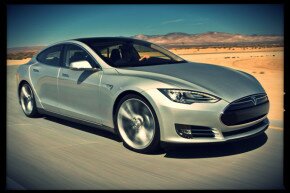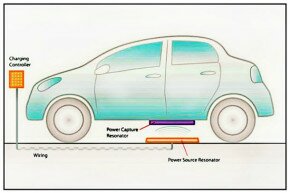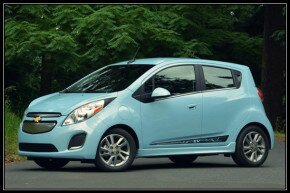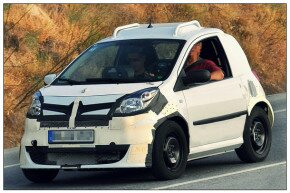Ford Ranger 2013
 |
The all-new 2013 Ford Ranger has been redesigned, it might appear to have blunt styling, but it is surprisingly aerodynamic. This pickup truck is now stronger and delivers more payload and class-leading towing capability, along with an innovative, new functions, comfort and assist the driver.
The 2013 Ford Ranger is a vehicle with a unitary steel body on a ladder frame, suspended by leaf springs and a live axle at the rear. By passenger car standards that sounds primitive, but for a pick-up expected to carry heavy loads on a flat load bay floor down severely rutted tracks, tow several tonnes and have the wheel articulation for proper off-roading, it’s accepted convention and the best technological solution available.
The Ranger is offered with a three-round cabin body – Regular Cab, Double Cab and Super Cab, which are among the most spacious in its class, the last being more of a two-plus-two set-up than the Double Cab; comes with a choice of two powerful and economical Duratorq TDCi diesel engine and propulsion formulas 4×2 (front wheel drive) and 4×4 (drive both axles).
A Regular Cab Ranger has the most outright carrying capacity, with a 2.3m-long load bay that can accommodate more than 1800 litres of covered cargo weighing just over 1.3 tonnes if needs be.

Underneath, the Ranger’s frame is longer and wider than before. It’s twice as stiff, too, and is mounted to the body via hydraulic fluid-filled rubber bushes for the best possible rolling refinement. Front suspension switches from torsion springs to coil-overs and wishbones, again for better ride tuning. There’s now sound insulation in the doors, underbody and roof, and double door seals for better wind insulation.
The Ranger is also the first pick-up to score a five-star EuroNCAP crash test rating. All this is intended to make it more agreeable to passenger car tax exiles.
Power comes from a choice of 2.2-litre four-cylinder and 3.2-litre five-cylinder turbodiesel engines, developed from those found in the Transit range. They drive through the rear wheels unless you switch to four-wheel drive, which you can do at up to 70mph. There’s a low-range transfer case too, with reduction gearing of 2.48:1 but no locking rear differential. Ford claims its latest traction control system is good enough to do the job of an old-fashioned lockable diff.

Inside, the 2013 Ford Ranger features similar ergonomics as the North American Focus sedan. The center stack is simple, sparse, and easy to interact with as only three climate control knobs and an AM/FM radio are present. Storage space is abundant in the T6 Ranger with two spots to stash a cellphone, wallet, or other pocket-size gear in the center stack alone. The instrument cluster is clean and well-organized with only the essential tachometer, fuel, oil temperature, and speedometer taking up space behind the steering wheel. A digital odometer sits below both the fuel and oil temperature gauges while being book-ended by the tach and speedometer.
The material mix isn’t quite the match of a high-end Focus, but it’s rich enough to avoid any commercial impression and outclass the pick-up standard. Fixtures and fittings are solid and sensibly sized, in order to allow operation while wearing thick gloves.
It has four seats in two sitting rows. Passenger space is fine and as generous in both rows as a medium-sized family car. There are lots practical storage solutions, too. The air conditioned centre cubby is big enough for a pack of drinks cans and the glovebox is sized for a 16in laptop. The rear seat cushions also lift to reveal a large storage box.
Between that storage box and the 1.5m-long load bay, there’s little that you could carry in a large estate car or SUV that you couldn’t in the Ranger. There’s no load-through facility, but longer items could be lashed to the roof rack of a car so equipped. There’s also a tailgate rated to carry 200kg, so you need have no qualms about climbing on to it to reach a bag or box.

It’s quiet at idle and at fairly low revs, and its vibrations are kept well under control, but the 3.2-litre ‘Puma’ five-pot in this Ranger is still obviously a Ford commercial unit. It pulls with grumble-free force from just above 1000rpm, but even when it begins to emit a few multi-cylinder harmonics higher up its vocal range, you know that it’ll be gasping for breath before 4000rpm comes and goes.
Easy pulling power is what this powertrain is specified to deliver, and that it achieves very well. Torque peaks at 347lb ft, but 300lb ft is on offer between 1300rpm and 3300rpm. Which means, once you’ve got the Ranger rolling and up into fifth and sixth, it’s a surprisingly effortless drive. Rarely will you need to change down – be that to climb, overtake or just accelerate on the motorway.
Don’t confuse this for a fast car, but it’s not desperately slow, either. A sub-11sec 0-60mph time would have been competitive with a big four-cylinder, mass-market 4×4 not so long ago. The most telling statistic is that cracking 30-70mph in fourth takes 11.7sec – just a second slower than it will take if you trawl through the gears instead.
Should running costs take priority over performance, the smaller 2.2-litre diesel is worth considering. It is available with either 123 or 148bhp. We found the latter to be a strong performer owing to its 277lb ft of torque which, whilst some way off the 3.2′s headline figure, is still enough to make decent progress.Whichever engine you choose, it’s better to think of the six-speed gearbox as a five-speeder with a dog-leg first. The real first gear is so short that it’s only really useful off road and for towing.
The shift quality is poor, though. It’s elastic, heavy and vague, and at times can feel more like you’re forcing a dislocated limb back into its socket than trying to select another gear. But that’s one entirely tolerable shortcoming in a car that, in most other respects, performs like a slightly heavier-duty family 4×4.

In the new Ranger, Ford has created a class-leading vehicle that not only betters its rivals on pick-up considerations such as carrying, towing and wading, but could also present a dilemma to many who run a big family car on their employer’s fleet.
It isn’t well mannered or well appointed enough to quite measure up to big passenger car standards, but it gets amazingly close. But for practical people who could put its ruggedness and utility to good use, and who care more about value and dependability than aspirational allure, it’s a genuine contender.
















Leave a Reply